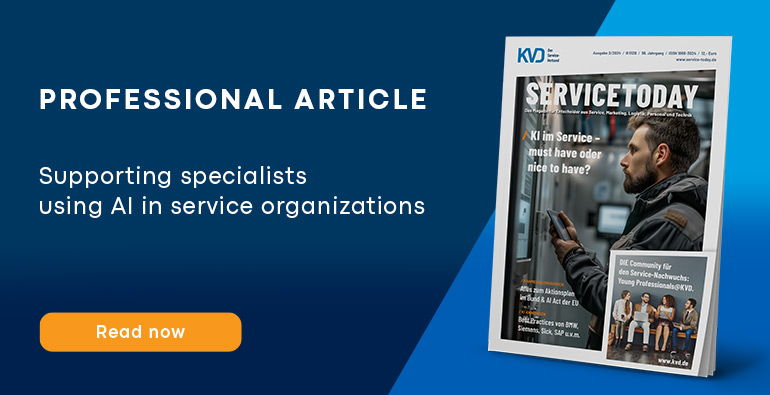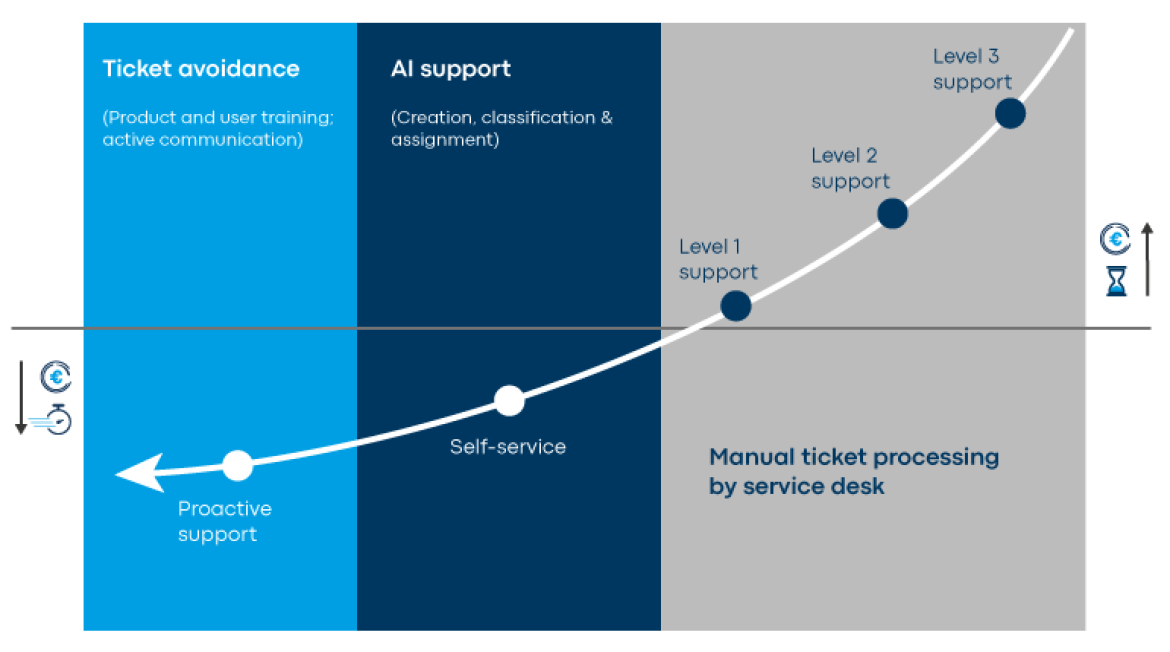Professional article: Supporting specialists using AI in service organizations

The use of artificial intelligence offers great economic potential in many business areas—scarce human resources are a driver here that continues to fuel the AI market. Critics, on the other hand, usually argue that AI systems consume an enormous amount of time and resources in terms of the necessary hardware and expertise for customized use. Questions about data and information protection are also often not sufficiently answered. Thirdly, the technical quality of the results must not be inferior to that of experienced human employees. The requirements for the use of AI technologies in service organizations are therefore high.
What tasks can AI reliably take on today?
First of all, it must be made clear that no two AIs are absolutely identical in every industry and in every area of application. AI is simply the method that is used to achieve individual goals. In most cases, this goal is to save time through automated or at least partially automated actions. An AI that assists with credit rating decisions for private individuals, for example, can only be compared to an AI used in service management to a very limited extent. Especially as the individual specialist expertise of your own company in the form of training data must be sufficient and of good quality for reliable results. If these criteria are met, AI systems can already provide useful support for the following service management tasks, for example:
- Reading out relevant information from a message and describing the core content
- Ticket creation including classification and categorization based on the data read out
- Searching for a proposed solution with a link to the most likely solution (e.g. in the knowledge database)
- (up to) generation of complete answers from general and specific knowledge context
A good service management software can use customized workflows to assign the request directly to an available, suitable employee (routing) based on the AI analysis, for example, and initiate corresponding approval steps by a human agent if the result and answer are suggested. Theoretically, complete and fully automated processing or answering of the request would also be possible (so-called “dark processing”); however, it is recommended that this is first introduced in intermediate steps in order to always guarantee the quality of the results. The use of AI increases the urgency of structurally tidying up your own service management tool. If artificial intelligence is to help with the automatic categorization of requests, for example, then the category structures should be properly maintained; categories should no longer overlap thematically. This also makes it easier to process all tickets, as the category can also be assigned more clearly and quickly during manual processing.
The shift-left approach in practice

The shift-left approach attempts to reduce the ticket volume and minimize the necessary processing resources in service management through the use of technology and the structured provision of information. On the “left” of this analogy is proactive ticket avoidance; to the “right” is self-service, followed by the familiar service levels: 1st level to 3rd level support on the far right. The further to the left on the curve an issue is resolved, the more favourable it is from the service organization’s perspective. In practice, the shift-left approach is achieved through instructions, user training, rule-driven automation and the use of AI for information extraction, categorization or the proposed solution.
Training process and development of the company’s own AI system
The foundation of any practical implementation is the training material that is available to the AI system. The better the data set of historical tickets is maintained and structured, the better the results of the subsequent training will be. However, even with very little data material, it can be worth starting to use AI in service management—just with more intermediate steps.
The first step is to collect all available ticket data. Most ticketing tools allow for a usable export of the ticket history. The AI now checks the tickets for correlations between ticket content, ticket classification and existing solution. This “training” takes place on an AI platform and can either be operated locally (on-premises) with the appropriate budget or outsourced to a service provider via a cloud solution. An individual training model is then transferred back from this AI system and integrated into the ticketing tool used in-house. When a new ticket comes in, the training model can now extract the content and make suggestions for classification and resolution.
If the results are already convincing, there is theoretically no need for new resource-intensive training by the AI platform for the time being. In practice, the ticketing tool works with this model via an interface to the AI platform—it is also possible to control several models via an interface. The AI model’s suggestions are sometimes accepted by the service employee, sometimes rejected and sometimes set correctly. This creates an even better ticket database over time. This ticket data can then be sent back to the AI platform (either via the cloud or on-premises) as training material. The result is a new training model that delivers higher success rates for the suggestions, as the data set is now larger and better. Without this renewed trip to the AI platform's “training center”, the quality of the AI performance would remain permanently stuck at the same quality level—provided, of course, that newer tickets are similar in structure and content to historical ones. It also makes sense to filter so that only ticket data from the last twelve months is used, for example.
When a new training session is triggered with more up-to-date ticket data depends on the desired quality (i.e. what percentage should the AI guess the correct solution) and homogeneity (how similar are tickets?). If the training material does not change fundamentally, then retraining is unlikely to produce more reliable suggestions. The time and hardware resources required for data training are influenced by the amount of data and the complexity of the tasks that the AI platform is supposed to learn.
Find out how artificial intelligence boosts the performance of your service desk in our AI factsheet.
Summary and future prospects
To remain competitive, service providers and internal IT departments must not close their minds to new technologies. In combination with chatbots, rule-driven automation via BPMN and other technologies, service quality and efficiency are increased, while costs are reduced at the same time. AI technologies already exist in other service fields outside of service management - such as predictive maintenance, route optimization for field service and chatbots. AI support enables further synergy effects within the service landscape. When it comes to AI integration, the service management software used must therefore be flexible. The trend here is clearly moving towards a cross-departmental service management platform.
Last but not least, artificial intelligence should not replace service personnel. Rather, it is about supporting manual ticket processing by automating or at least preparing low-threshold, but time-consuming and click-intensive tasks. This keeps the focus on quality assurance. Especially in times of a shortage of skilled workers, existing resources need to be used in the best possible way, which means proactively investing in your own service management.
About the author

Christian Schüle, Head of Product Management, OMNINET
As Head of Product Management with 15 years of experience in service management software, Christian is responsible for the functional and strategic roadmap of the OMNITRACKER business process platform as well as other products from the OMNINET software portfolio. This involves interdisciplinary tasks in the context of requirements management, stakeholder management and requirements discussions with existing and target customers across all industries and constant analysis of market developments.
This article has already appeared in the magazine SERVICETODAY, which is published by the service association KVD.
About the magazine SERVICETODAY
The Fachmagazin SERVICETODAY is published by the service association Service-Verband KVD e.V., based in Dorsten, Germany, and published by ISB-Verlag, Waltrop, Germany. The magazine for decision-makers in service, marketing, logistics and technology has been on the market for over 30 years and provides information on management, organization and practice in service, on technical trends, their economic and organizational impact, on continual development and personnel management, on people, products and companies in the service sector.
The service association Service-Verband KVD supports its members by using its expertise and experience to identify and explain relevant service trends and developments in the areas of people, technology, processes and the environment, as well as translating them into recommendations for action. With various formats, the KVD offers its members access to knowledge, networks and interaction from practice, business and science, with which they can shape and achieve their personal and corporate success for the future.
Newsletter sign-up
Would you like to stay up to date on digital service management, GRC and automation? In our newsletter, we inform you about relevant blog posts and professional articles. We also regularly send you information about events, DACH-wide trade fairs and our free live sessions in the areas of service management, process automation, GRC and analytics with business intelligence. We will inform you about new features of the OMNITRACKER business process platform.
